An Improved Adaptive Kalman Filter Positioning Method Based on OTFS
Abstract
1. Introduction
- To mitigate the impact of Doppler effects on traditional OFDM ranging in dynamic environments, OTFS modulation is employed for distance estimation. Exploiting its sparse representation in the delay–Doppler domain enables more robust and accurate ranging under high mobility.
- An improved adaptive Kalman filtering algorithm is proposed, incorporating region partitioning and genetic factor selection. By dynamically adjusting filtering parameters according to different positioning environments, the algorithm achieves enhanced adaptability and robustness, thereby significantly improving localization accuracy in complex scenarios.
- The simulation results demonstrate that, compared with traditional methods, the method proposed in this article significantly improves positioning accuracy and stability in complex environments, highlighting its strong application potential.
2. Fundamental Theory
2.1. OTFS Modulation
2.2. TDOA Algorithm
2.3. Adaptive Kalman Filtering
3. Improved Adaptive Kalman Filter Algorithm Based on 6G-OTFS Modulation Signals
3.1. OTFS Ranging
3.2. Improved Adaptive Kalman Filter Positioning Method
4. Simulation Experiments and Analysis
4.1. Accuracy Evaluation Metrics
4.2. Ranging Performance Analysis
4.3. Performance Analysis of Different Positioning Methods
4.4. Performance Analysis Under Different Genetic Factors
5. Conclusions
Author Contributions
Funding
Institutional Review Board Statement
Informed Consent Statement
Data Availability Statement
Conflicts of Interest
References
- Zhu, Y.; Mao, B.; Kato, N. IRS-aided high-accuracy positioning for autonomous driving toward 6G: A tutorial. IEEE Veh. Technol. Mag. 2023, 19, 85–92. [Google Scholar]
- Chen, H.; Munir, S.; Lin, S. Rfcam: Uncertainty-aware fusion of camera and wi-fi for real-time human identification with mobile devices. Proc. ACM Interactive Mobile Wearable Ubiquitous Technol. 2022, 6, 49. [Google Scholar] [CrossRef]
- Zhao, Y.; Li, Z.; Hao, B.; Shi, J. Sensor selection for TDOA-based localization in wireless sensor networks with non-line-of-sight condition. IEEE Trans. Veh. Technol. 2019, 68, 9935–9950. [Google Scholar]
- Zhao, M.; Zhang, T.; Wang, D. A novel UWB positioning method based on a maximum-correntropy unscented Kalman filter. Appl. Sci. 2022, 12, 12735. [Google Scholar] [CrossRef]
- He, S.; Yang, B.; Liu, T.; Zhang, H. Multi-Tag UWB Localization with Spatial-Temporal Attention Graph Neural Network. IEEE Trans. Instrum. Meas. 2024, 73, 2531112. [Google Scholar] [CrossRef]
- Feng, D.; Wang, C.; He, C.; Zhuang, Y.; Xia, X.-G. Kalman-filter-based integration of IMU and UWB for high-accuracy indoor positioning and navigation. IEEE Internet Things J. 2020, 7, 3133–3146. [Google Scholar] [CrossRef]
- Motie, S.; Zayyani, H.; Salman, M.; Bekrani, M. Self UAV localization using multiple base stations based on TDoA measurements. IEEE Wirel. Commun. Lett. 2024, 13, 2432–2436. [Google Scholar] [CrossRef]
- Feigl, T.; Nowak, T.; Philippsen, M.; Edelhäußer, T.; Mutschler, C. Recurrent neural networks on drifting time-of-flight measurements. In Proceedings of the 2018 International Conference on Indoor Positioning and Indoor Navigation (IPIN), Nantes, France, 24–27 September 2018; pp. 206–212. [Google Scholar]
- Mohammadi, M.; Al-Fuqaha, A.; Guizani, M.; Oh, J.-S. Semisupervised deep reinforcement learning in support of IoT and smart city services. IEEE Internet Things J. 2017, 5, 624–635. [Google Scholar] [CrossRef]
- Ye, X.; Yin, X.; Cai, X.; Yuste, A.P.; Xu, H. Neural-network-assisted UE localization using radio-channel fingerprints in LTE networks. IEEE Access 2017, 5, 12071–12087. [Google Scholar]
- Dai, L.; Wang, Z.; Wang, J.; Yang, Z. Positioning with OFDM signals for the next-generation GNSS. IEEE Trans. Consum. Electron. 2010, 56, 374–379. [Google Scholar]
- Wang, D.; Fattouche, M.; Ghannouchi, F.M. Multicarrier code for the next-generation GPS. EURASIP J. Wirel. Commun. Netw. 2012, 2012, 185. [Google Scholar] [CrossRef]
- Driusso, M.; Comisso, M.; Babich, F.; Marshall, C. Performance analysis of time of arrival estimation on OFDM signals. IEEE Signal Process. Lett. 2014, 22, 983–987. [Google Scholar] [CrossRef]
- Gao, K.; Wang, H.; Lv, H.; Liu, W. Localization-oriented digital twinning in 6G: A new indoor-positioning paradigm and proof-of-concept. IEEE Trans. Wirel. Commun. 2024, 23, 10473–10486. [Google Scholar] [CrossRef]
- Hadani, R.; Rakib, S.; Tsatsanis, M.; Monk, A.; Goldsmith, A.J.; Molisch, A.F.; Calderbank, R. Orthogonal time frequency space modulation. In Proceedings of the 2017 IEEE Wireless Communications and Networking Conference (WCNC), San Francisco, CA, USA, 19–22 March 2017; pp. 1–6. [Google Scholar]
- Zhang, S.; Tong, X.; Chi, K.; Gao, W.; Chen, X.; Shi, Z. Stackelberg game-based multi-agent algorithm for resource allocation and task offloading in mec-enabled c-its. IEEE Trans. Intell. Transp. Syst. 2025, 1–12. [Google Scholar] [CrossRef]
- Zheng, Y.; Zhou, F.; Zhang, W. New error-bounds with nlos toa localization and the applications. IEEE Commun. Lett. 2024, 28, 1835–1839. [Google Scholar] [CrossRef]
- Jia, T.; Liu, H.; Ho, K.; Wang, H. Mitigating sensor motion effect for AOA and AOA-TOA localizations in underwater environments. IEEE Trans. Wirel. Commun. 2023, 22, 6124–6139. [Google Scholar] [CrossRef]
- Wang, E.; Wang, Y.; Zhang, S.; Xu, S.; Chen, Y.; Wang, Y.; Yu, T.; Lei, H. High-Precision UWB TDOA Localization Algorithm Based on UKF-FNN-CHAN-RIC. IEEE Trans. Instrum. Meas. 2025, 74, 8506813. [Google Scholar] [CrossRef]
- Jiang, R.; Yu, Y.; Xu, Y.; Wang, X.; Li, D. Improved Kalman filter indoor positioning algorithm based on CHAN. J. Commun. 2023, 2, 136–147. [Google Scholar]
- Zhang, P.; Wen, H.; Liu, X.; Niu, L. A new time-delay estimation: Phase difference-reassigned transform. Int. J. Dyn. Control 2024, 12, 4315–4327. [Google Scholar] [CrossRef]
- Cheng, Y.; Zhou, T. UWB indoor positioning algorithm based on TDOA technology. In Proceedings of the 2019 10th International Conference on Information Technology in Medicine and Education (ITME), Qingdao, China, 23–25 August 2019; pp. 777–782. [Google Scholar]
- Martalò, M.; Perri, S.; Verdano, G.; De Mola, F.; Monica, F.; Ferrari, G. Hybrid UWB-inertial TDoA-based target tracking with concentrated anchors. IEEE Internet Things J. 2023, 10, 12676–12689. [Google Scholar]
- Hua, C.; Zhao, K.; Dong, D.; Zheng, Z.; Yu, C.; Zhang, Y.; Zhao, T. Multipath map method for TDOA based indoor reverse positioning system with improved Chan-Taylor algorithm. Sensors 2020, 20, 3223. [Google Scholar] [CrossRef]
- Zhu, Y.; Cui, B.; Han, D.; Zhu, Y.; Gao, Y.; Liu, S. A Coarse Alignment Algorithm Based on Vector Reconstruction via Sage–Husa AKF for SINS on a Swaying Base. Sensors 2025, 25, 5274. [Google Scholar] [CrossRef]
- Yan, X.; Zhao, L.; Tang, C.; Zou, J.; Gao, W.; Jian, J.; Jin, Q.; Zhang, X. Intelligent MEMS Thermal Mass Flowmeter Based on Modified Sage-Husa Adaptive Robust-Strong Tracking Kalman Filtering. IEEE Sens. J. 2024, 25, 283–290. [Google Scholar] [CrossRef]
- Su, Y.; Han, J.; Ma, C.; Wu, J.; Wang, X.; Zhu, Q.; Shen, J. Adaptive kalman filter based on online ARW estimation for compensating low-frequency error of MHD ARS. IEEE Trans. Instrum. Meas. 2024, 73, 9509510. [Google Scholar] [CrossRef]
- Juston, M.; Gupta, S.; Mathur, S.; Norris, W.R.; Nottage, D.; Soylemezoglu, A. Robust Error State Sage-Husa Adaptive Kalman Filter for UWB localization. IEEE Sens. J. 2025, 25, 16034–16049. [Google Scholar] [CrossRef]
- Chen, L.; You, C.; Wang, Y.; Li, X. Variable-Speed UAV Path Optimization Based on the CRLB Criterion for Passive Target Localization. Sensors 2025, 25, 5297. [Google Scholar] [CrossRef] [PubMed]
- Li, T.; He, R.; Ai, B.; Yang, M.; Zhong, Z.; Zhang, H. OTFS modulation performance in a satellite-to-ground channel at sub-6-GHz and millimeter-wave bands with high mobility. Front. Inf. Technol. Electron. Eng. 2021, 22, 517–526. [Google Scholar] [CrossRef]


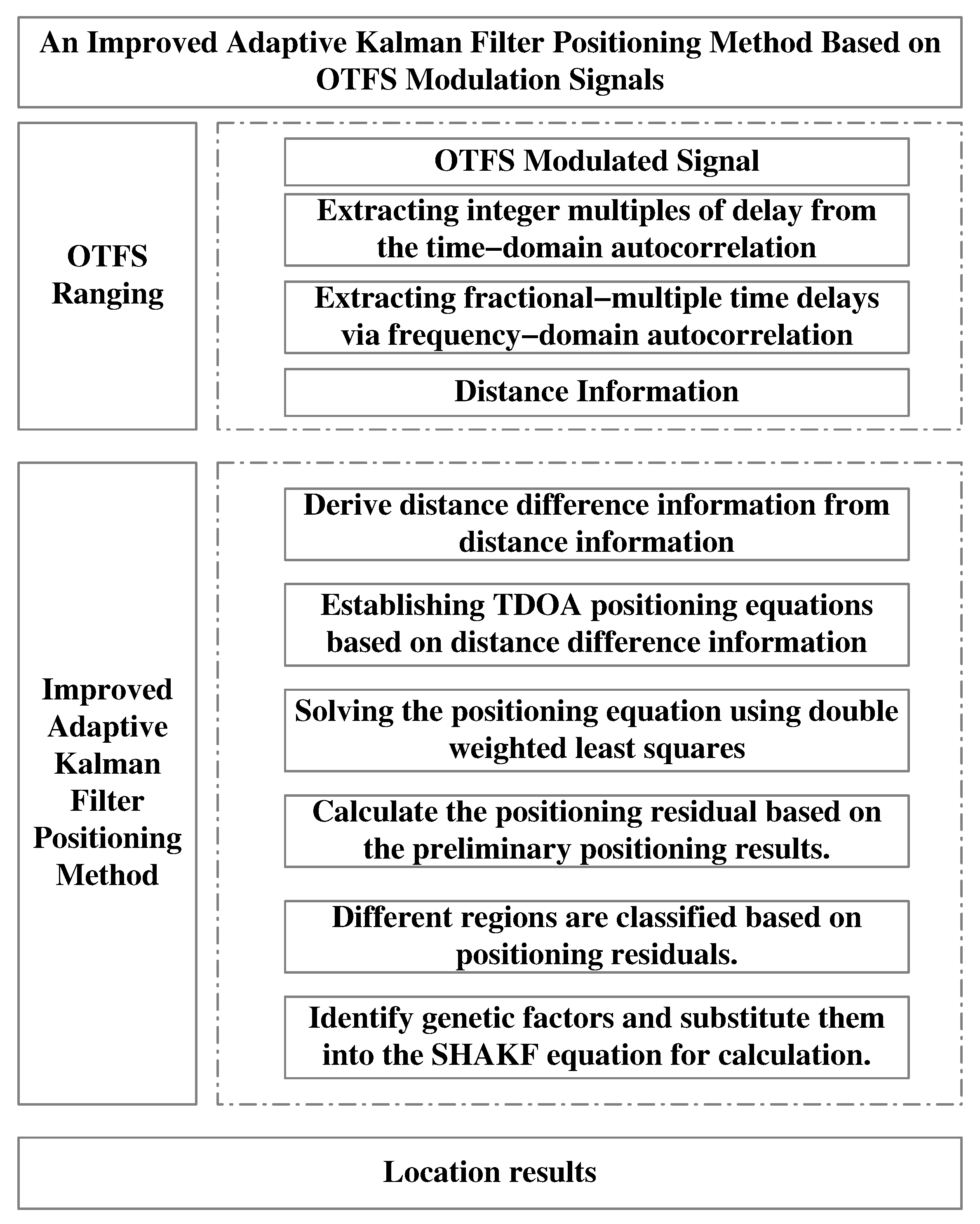

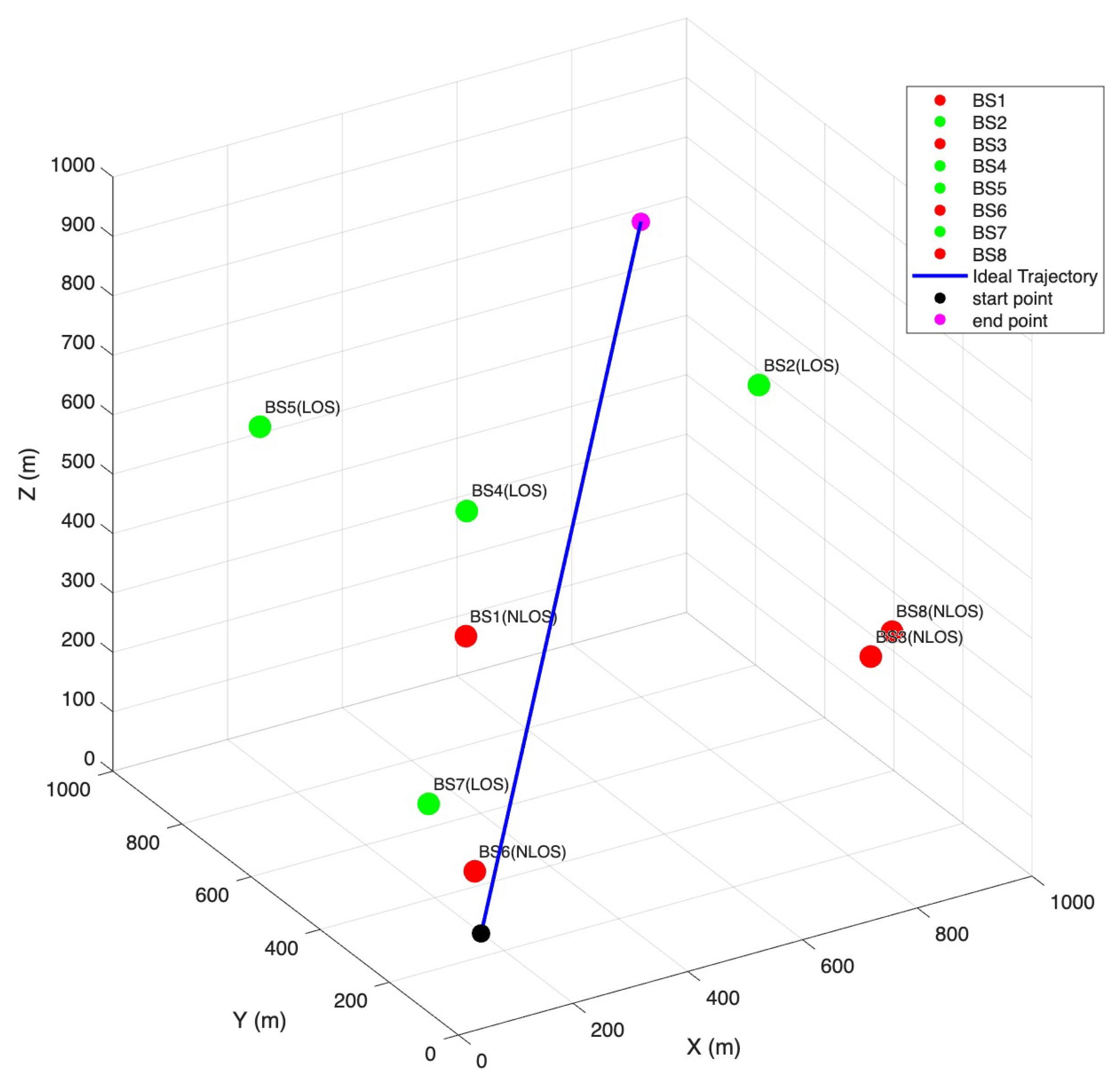
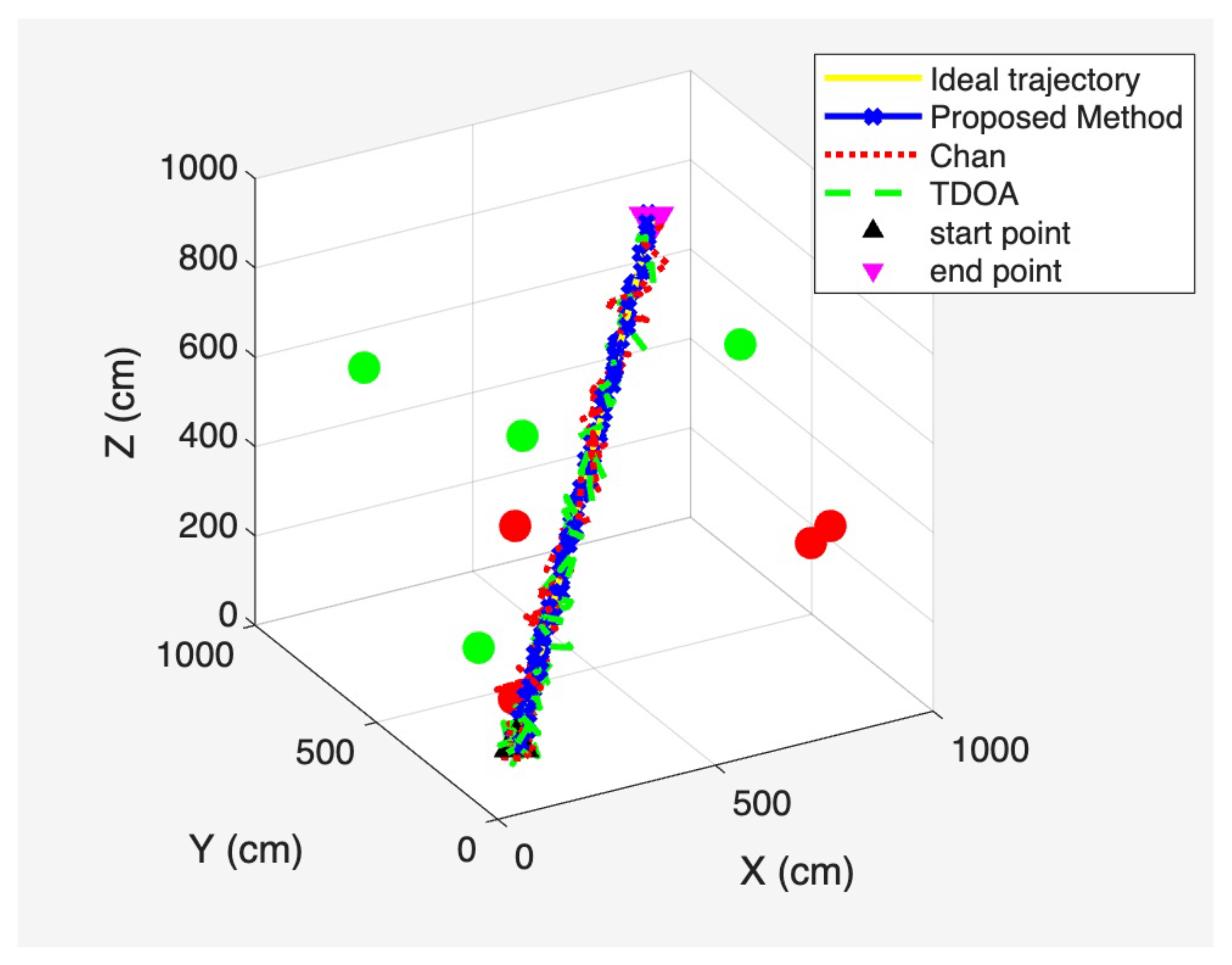

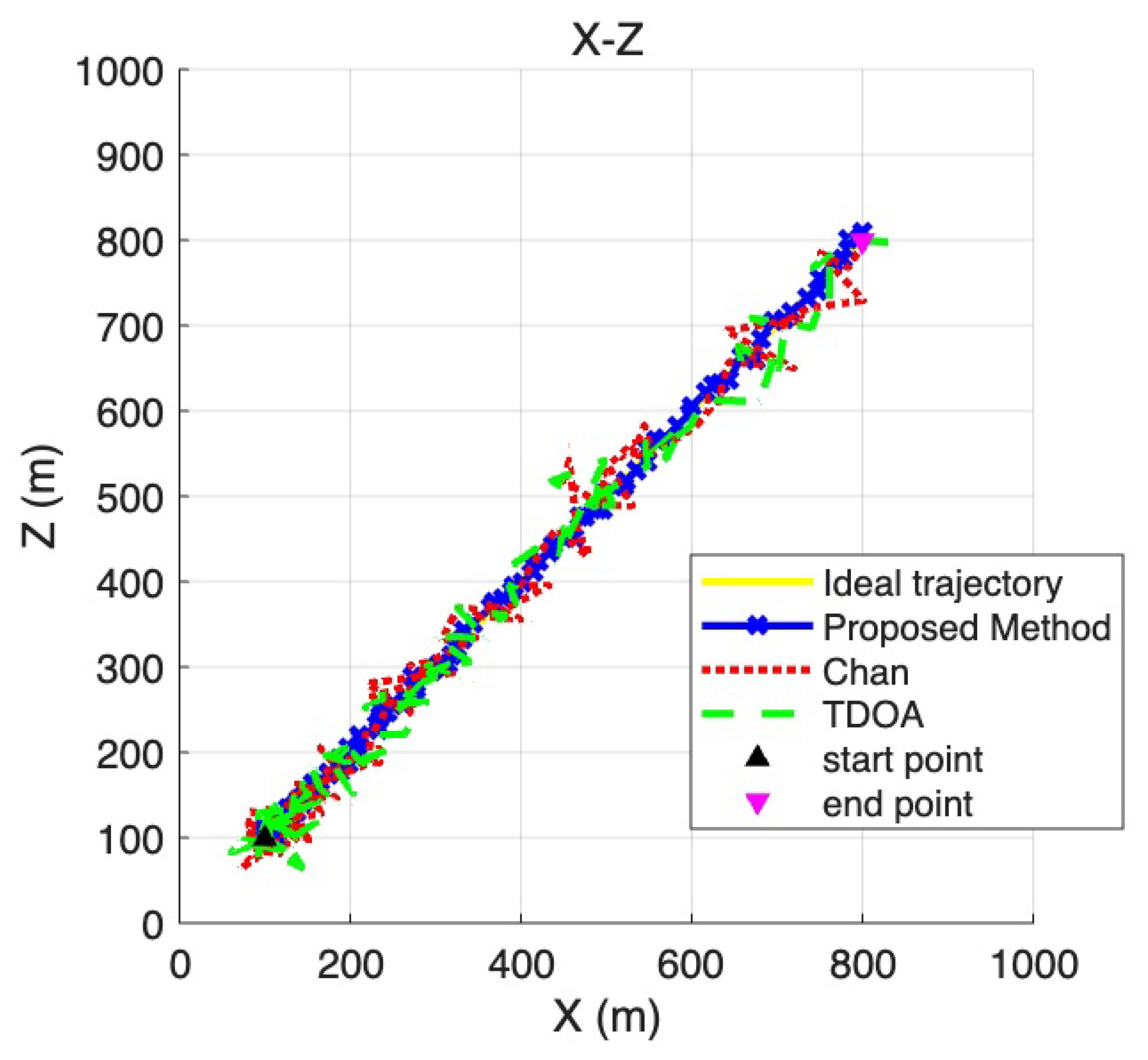
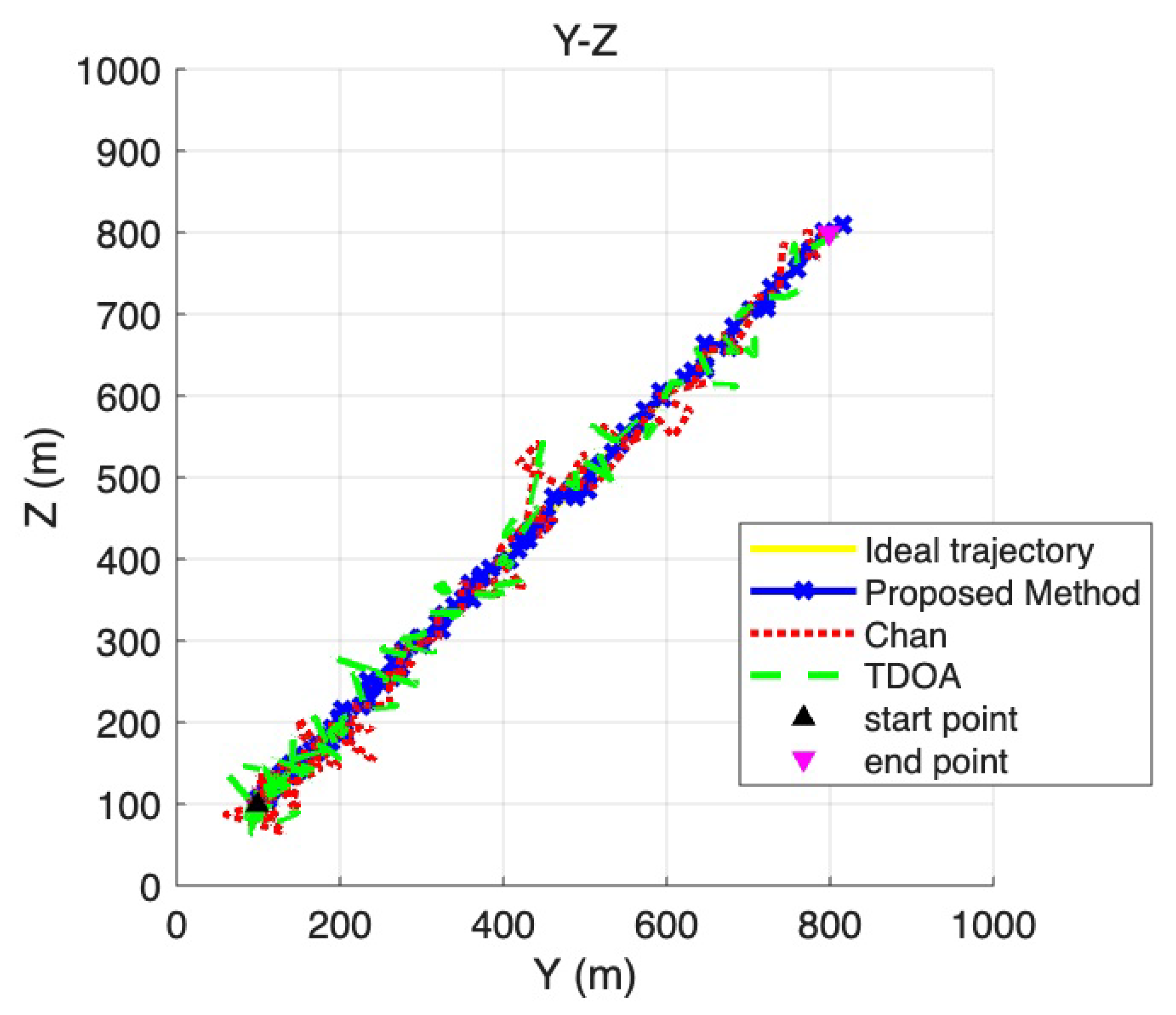
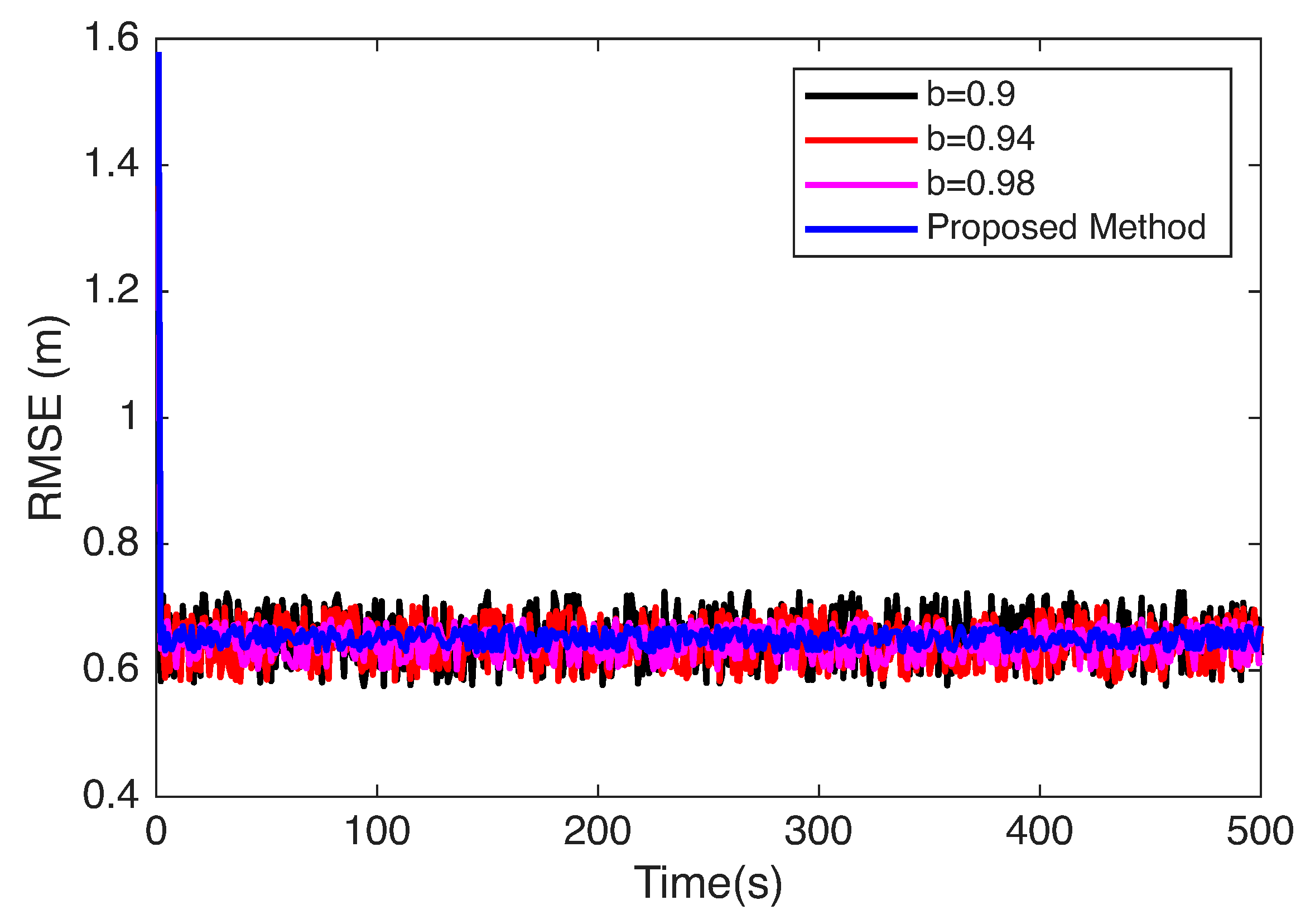
| Simulation Environment | Value |
|---|---|
| Space size | 1000 m × 1000 m × 1000 m |
| LOS signal and NLOS signal probability | 50% |
| Start point | (100 m, 100 m, 100 m) |
| End point | (800 m, 800 m, 800 m) |
| Error distribution | Additive Gaussian white noise |
| Number of base stations | 8 |
| Method | RMSE (cm) | Operating Time (s) |
|---|---|---|
| TDOA | 201.795 | 0.054 |
| Chan | 144.153 | 0.097 |
| Proposed Method | 65.362 | 0.619 |
Disclaimer/Publisher’s Note: The statements, opinions and data contained in all publications are solely those of the individual author(s) and contributor(s) and not of MDPI and/or the editor(s). MDPI and/or the editor(s) disclaim responsibility for any injury to people or property resulting from any ideas, methods, instructions or products referred to in the content. |
© 2025 by the authors. Licensee MDPI, Basel, Switzerland. This article is an open access article distributed under the terms and conditions of the Creative Commons Attribution (CC BY) license (https://creativecommons.org/licenses/by/4.0/).
Share and Cite
Xia, S.; Liu, A.; Liang, X. An Improved Adaptive Kalman Filter Positioning Method Based on OTFS. Sensors 2025, 25, 6157. https://doi.org/10.3390/s25196157
Xia S, Liu A, Liang X. An Improved Adaptive Kalman Filter Positioning Method Based on OTFS. Sensors. 2025; 25(19):6157. https://doi.org/10.3390/s25196157
Chicago/Turabian StyleXia, Siqi, Aijun Liu, and Xiaohu Liang. 2025. "An Improved Adaptive Kalman Filter Positioning Method Based on OTFS" Sensors 25, no. 19: 6157. https://doi.org/10.3390/s25196157
APA StyleXia, S., Liu, A., & Liang, X. (2025). An Improved Adaptive Kalman Filter Positioning Method Based on OTFS. Sensors, 25(19), 6157. https://doi.org/10.3390/s25196157






